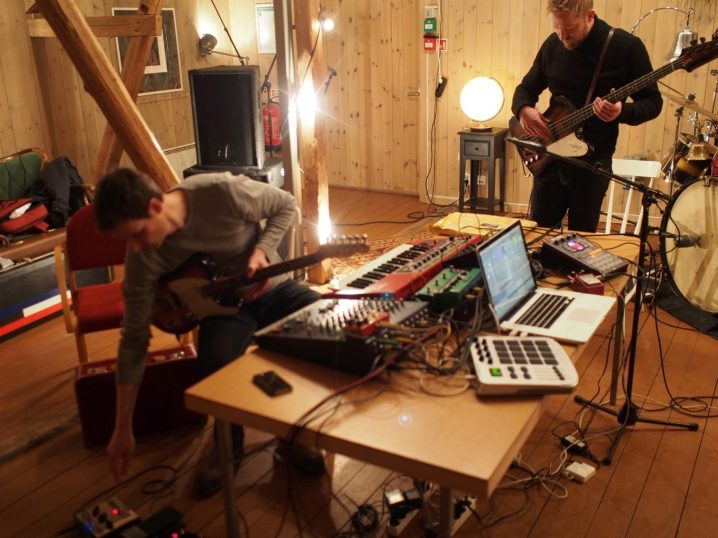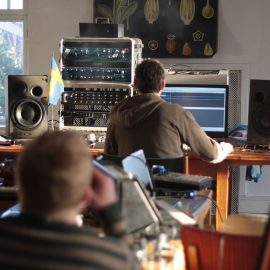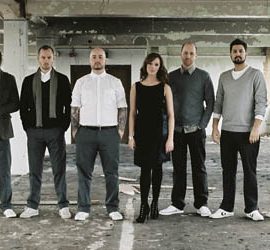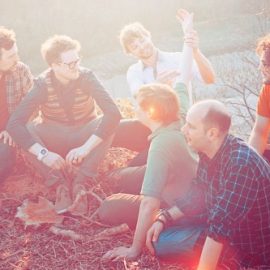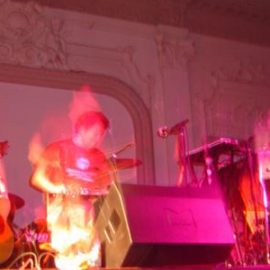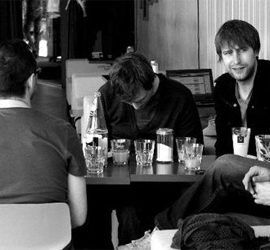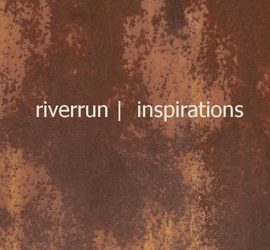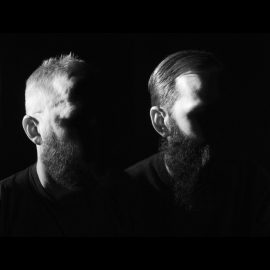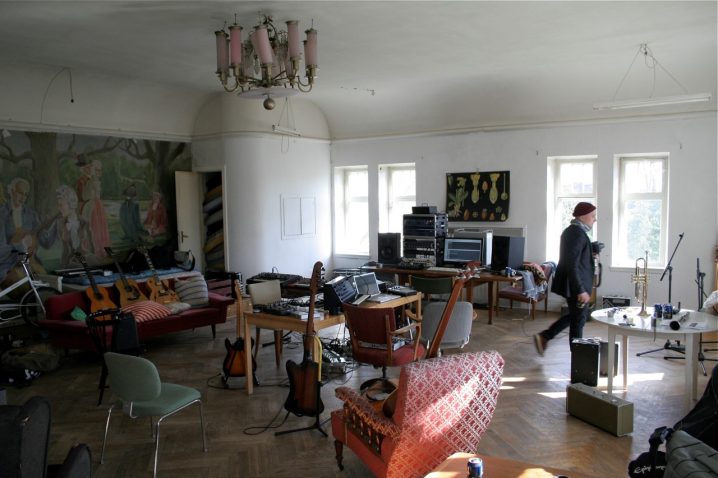
Can you tell us how you got involved in composing, and what was your very first piece of gear?
We are three in the band, so we all have different beginnings. All of us have played in rock bands in the late 1980’s, early 90’s. Thomas in the town of Esbjerg and Keld and Mads in Tønder. We started the classic garage way. The ususal guitars, bass, singing. Probably quite hideous, but loads of fun. Mads even played trumpet and saxophone in a band, and sang. So, there is, or was, this immense social capital associated with playing in a band at that time, which was probably why we did it. All the wrong reasons. Mads’ parents used to have a lot of musicians staying at their big house in southern Jutland. Some of them brought some synths along (probably a JX-8P or one of the old Roland Juno 60 or 106), and he sat down with a pair of headphones. When you can’t play the piano, you tend to sort of go for those pad sounds, the Brian Eno stuff where you don’t have to know chords. So that’s one story. When he was small, Keld actually started playing after he found a guitar floating in the water. He put strings on it, and started playing. Thomas chose the bass over the guitar because he thought it was easier.
More officially, Keld and Mads were in another band and the drummer sort of left, and we decided to get a sampler (AKAI S3000) – very expensive stuff at the time. Keld had a Macintosh 7300 which could do a bit of audio stuff in Studio Vision. Keld and Mads sort of started playing around with that, recording many mini discs along the way. Then Thomas, whom Mads knew from childhood, joined us with his Gibson Thunderbird bass on a demo we made back in 2000. He also got himself a small Moog Satellite – a not so impressive single oscillator Moog, but it´s sort of too bad that he sold it. But it felt natural to include the electric bass on all our tracks and the rest is history: we were a band.
How many different studio iterations have you gone through, and what does your final setup look like right now?
Many different places and setups. In the late 90’s, early 00’s we were mainly working at a console (the Behringer Eurorack – we even had the software that would save the settings for volume, eq, pans, sends etc running on a cheap PC). The Macintosh was still the main piece, and we started using Emagic (now Apple) Logic a lot. Also, we had the then new Novation Supernova, the AKAI S3000, the Clavia Micromodular (used a lot for filtering and lo-fi bit crushing) a Roland SH-2000 and a lot of MIDI wires. This was in a crap studio that we built ourselves. At some point around 2003-4 we were offered to be in a fairly fancy downtown studio. We hooked up with another guy who’s a ‘real’ producer (as in ‘does all the tricky mic setups for a full band’) and thus inherited a lot of gear. We got rid of the Eurorack and a lot of stuff. Also, we had moved to laptops (the Macintosh Wall street and later the iBook) after we had a break in in the studio and had our samplers stolen.
Right now the studio is in a bit of turmoil because we are trying to break some habits with the gear. For Hildur, a lot of the stuff was made on individual laptops – sometimes running Ableton Live, sometimes Max/MSP. We often record stuff in the studio on a stationary Mac connected to a Universal Audio Apollo 16 (which is close to the best you can buy at the moment) – guitars and bass are recorded through a Tube Tech MP-1A and a CL-1B. They sound great, as they should at that price. Acoustic guitar and acoustic bass are recorded with an AKG C414 and we go to some really nice Schoeps matched pair for more ambient recording, bells, marimba, the Fender Rhodes (eg. on the track “Geopold” on Hildur which features the Schoeps mikes catching the hammers and the pedal on the Fender Rhodes) and stuff. We rarely record guitar and bass in our sound proof box. When we recorded at Hotell Hildur in Sweden, we opted to just record in the room, catching whatever ambience was there.
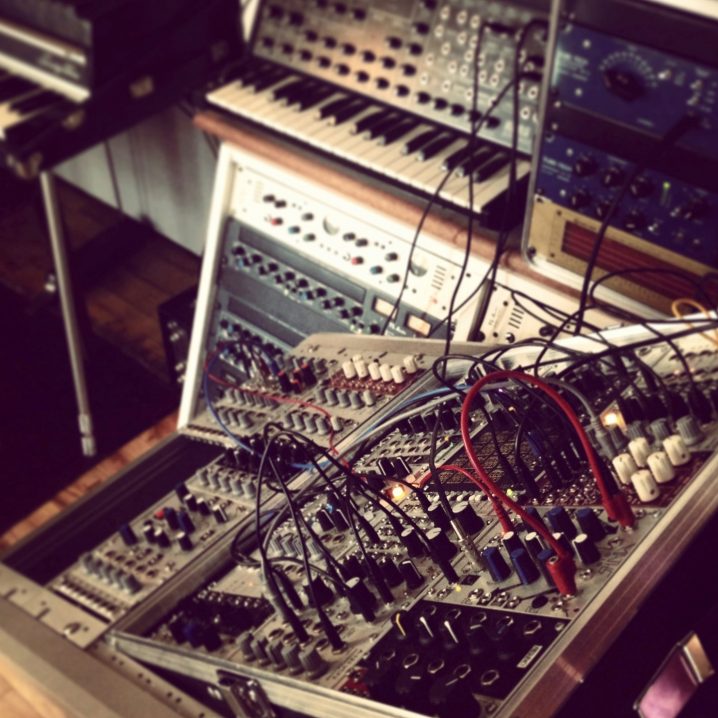
Tell us about your favorite piece of hardware.
Mads: Mine is currently the Roland SP-404 “table top” sampler. It’s a very limited, fairly slow sampler, but it’s nice and gritty, and you can do lots of silly stuff on it. Being limited is really nice when you are running Live on the side, as it allows you to concentrate on doing one thing well. You can hear the SP-404 all over the new album, mainly used as a tool to make things a bit less unpredictable. It plays a bit part on the track “Lares” on Hildur. Also, I recently just got the Elektron Analog 4, but I haven’t had time to go that deep with it yet.
Keld: A guitar – something that I could never imagine not having around somehow. Other than that, my ever growing modular synth.
Thomas: My Gibson Thunderbird bass
And what about the software that you use for production?
There is no doubt that Ableton Live is a great piece of software. We’ve been using it since about version 3, and it tends to become better and better. We are probably not terribly original in saying that it’s just great for improvising. We mainly use session mode. After having put some loops (often quite long ones), these then go into Logic for arrangement. It’s a question of taste – and maybe sound quality too – it seems to us that Logic sounds a bit clearer, a bit more relaxed than Live. So we currently mix in the box – often in Logic. There is something very tempting about mixing on a desk again, but arguably with the Push controller for Live and a set of faders, you can come up with some great versions.
Is there a particular piece of gear that you’re just dying to get your hands on and do you think one day you’ll have it?
There is lots of stuff, but whether it would actually improve anything. As gearheads, we’re committed to wanting stuff all the time, but at the same time it’s great to squeeze out every single possibility from one piece of gear. That’s what we did with the AKAI sampler many years ago. Some of this “dying to get” gear, tends to become somewhat cliché over time. This of course is the bank talking. If money was not an issue, what about an ARP-2600 or another supersynth of some kind? The Jupiter 8 maybe? A Buchla? They are probably pretty hyped, but why not? Dying to have changes all the time. Currently we are working a lot in the synth domain, and Keld is building a good sized modular synth. Which is great, because often what you want is something that has never been built. With all the small modular producers coming out (Intellijel, Make Noise, Mutable Instruments, Pitsburgh, etc. etc.) the result is that you can literally build the synth of your dreams, not being limited to those great dinosaurs like the ARPs, Moogs, or Roland monsters. A Tube Tech SMC 2BM Multiband Mastering Opto Compressor would be neat. There’s something that we will probably never be able to afford or prioritize – it’s around $5000)
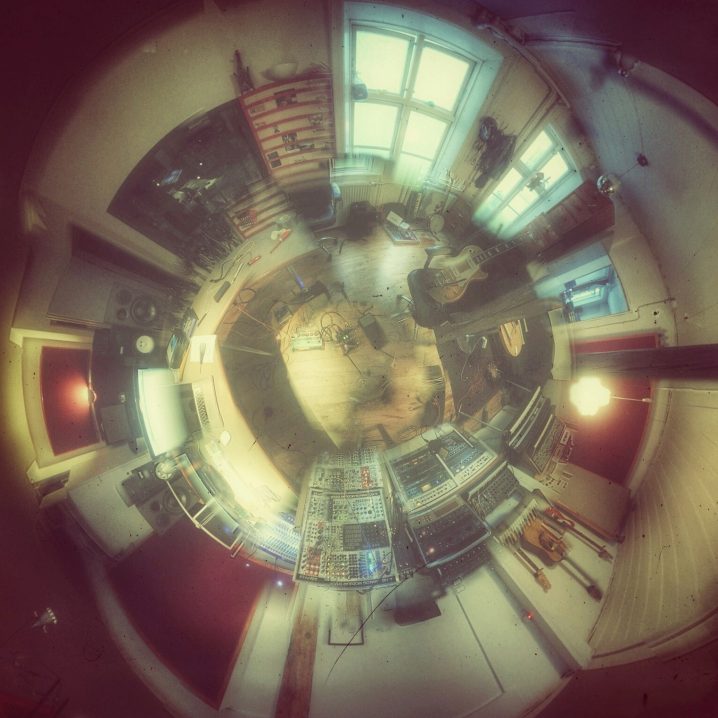
Can you share some aspects of sound design in your work?
We often have a lot of different layered tracks when we start out mixing a song in Logic – so there are two ways to avoid clogging the new song with stuff: Delete track or EQ track. We are maybe a bit protective to begin with, so the first trick to get a track to sit in the mix is EQ (mainly a handful of different Waves plugins, sometimes the Logic EQ) – you know, remove the 200 Hz, maybe around 1000Hz (where the guitar seems to sit better), maybe cut at 50-60Hz. That sort of thing. When that doesn’t work, delete it. Also, reverb: as high quality as you can afford. It does make a difference. Lastly, noisy guitars? hum or interference in the bass pick-ups? Bad tape recording or an initially annoying Roland filter? Leave it in. Noise is good. Once we did a session for a CD and we were listening to a reference track by Rhythm & Sound, and the producer went: ‘They should lose that noise – it would be so easy to EQ it out”…and we were like, nonono, that’s the whole point of the track, you know. Warm noise.
Any particular new techniques that you tried out for your new album?
We did a lot of recordings of bass and guitars for the new album. More than on the previous albums where recording live playing seemed more like a gesture. Such recordings provide the backdrop for most of the tracks on the album. Also, we have two tracks with a bit of singing. That is definitely something that we will be working more with.
What does your live setup look like, and what do you bring with you when you travel for an extensive tour?
So, we don’t do extensive tours, but our live setup is Mads running Live on his laptop, using a M-Audio trigger finger for controlling clips, sends, effects. Live has a send out to the Roland SP-404 that also runs through an old Ibanez bucket brigade delay. Very gritty. The whole thing is run over to Keld’s mixer that sends to a Line 6 delay and a TC Hall of Fame reverb. Also, Keld sends to a small box with a small selection of Eurorack modular modules like a sampler, a filter etc. Keld plays the guitar through a Pigtronix looper pedal synced to midi from Mads. Thomas plays the bass through a small preamp that also goes to Keld’s mixer. It is very much a compromise of size/portability and flexibility. The great thing is that the setup feels very loose. There are a ton of music ideas that can go wrong with the setup, and it forces us to be on our toes all the time. Being challenged in terms of communicating/improvising along the way makes for a more exciting and musical set.
What is the most important environmental aspect of your current workspace and what would be a particular element that you would improve on?
More space in the studio, more permanent setup for recording “live” impro sessions, less patchbay – less recording booth. One big room with some movable sound ‘stations’ for each of us would be great.

What can you tell us about your overall process of composition? How are the ideas born, where do they mature, and when do they finally see the light?
Often the sequence is something like this: Mads plays around with a small idea in Live at home (a snippet of a melody, a loop, a rhythm, brings it to studio, Thomas and Keld turn it in a completely different direction when they add bass and guitar. Then they tend to lie around on the stationary Mac in the studio for a while. Often, during that time, Keld does a lot of the editing and, the arrangement and Thomas comes with input to that process.
One of the things that we are trying to accomplish, sound wise, is to make the composition seem as natural as possible – i.e. it’s not supposed to sound as though you just threw some guitar and bass on top of a loop. That takes a lot of time, to strike the right balance between acoustic elements and electronics. But when the balance is there, and when there is enough stuff in the mix to catch your attention, without it seeming crowded, – then the track is good to go to mastering. Listen to “Palinode” on Hildur, there is clearly a lot of electronic stuff going on, but the guitar and bass play a natural role in that space. By the way, does it remind you a bit of Leonard Cohen’s “Suzanne”? It was not intentional!
Another example is Four Colours where the scape, the electric guitar, the bass (with a chorus pedal), the cymbals and the drum machine through a spring reverb melt into something meaningful.
What gets you inspired?
Inspiration probably starts somehow from the instruments themselves. It is hard to explain, and it would be easier to say “nature” or “city life”, but in reality the challenge of working with complex instruments and the accidents that occur along the way are very inspiring. After having experimented with the technology – the bass, guitar, the plug-in, the synth – for a while, other sources of inspiration begin surface. Sometimes a sound reminds you of something or gets you in a certain mood. There is this constant push and pull between the technology, your experiences of nostalgia, landscape memories, and the immediate context – having other people around you in the studio and so on. But it probably starts with the instruments themselves.
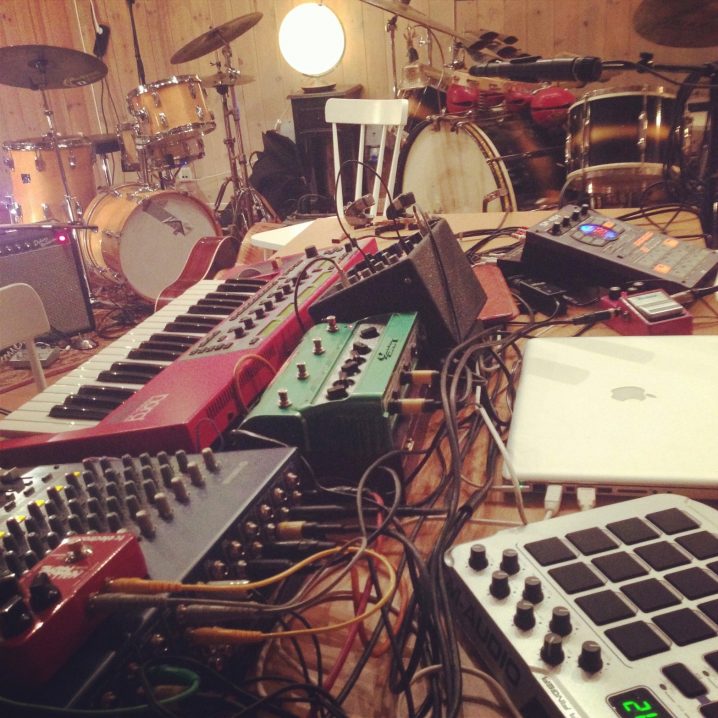
And finally, what are your thoughts on the state of “electronic music” today?
Wow. One of the impulses when we started making music with samplers and stuff was to produce the kind of music that we liked. Because we were not completely convinced that there was that much to like when we started. Maybe, to an extent it was an artifact of not having access to that much music really. Not compared to today anyway. So, the technologies of distribution as well as the technologies of production have most certainly changed the past 10 years, and there is so much fantastic music out there for people to listen to.
In a sense there is at the same time a sort of counter reaction in the way that people are also finding a way back to “the old ways” like using modular synths and analogue recording, releasing vinyl (or cassette tapes) or at least incorporating a lot of those elements. It seems people actually make an effort in that way. The risk, of course, is that you simply re-run ideas. VHS-wave or whatever is great, but when you think about it, it can also feel a bit nostalgic on the verge of being sentimental.
Another thing that is quite frustrating when you talk about “electronic music” (which is probably why you put it in quotation marks) is that we need to qualify that term much better. More and more, we don’t consider ourselves “electronic music” artists, but simply as musicians. It is relatively banal, but the reality is that most music that you hear today can somehow be classified as “electronic music”. The term makes a lot less sense these days. When we started out, it was not unusual for people to say that they did not like “electronic music” or found the idea of making music like we did somehow offputting. The way we do things is far more accepted today, and that is certainly a good thing. But it makes it harder to classify.
Lastly, a development that is often lamented is the decline of the album as a form. Nothing to do with electronic music as such, even if single releases and quick turn around times for artists is maybe more pronounced with the bedroom producers. We, as a band, grew up with the album, and we have a hard time giving that up. Talk about nostalgic, but we just like the idea of the album as a form. What to do?
